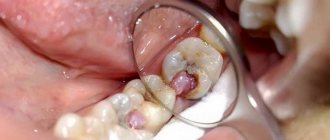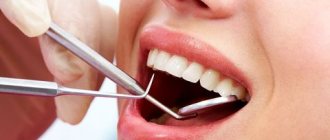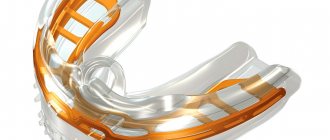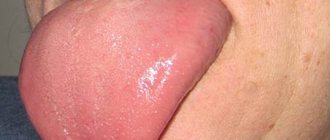For pulpitis, fistula or deep caries, several stages of therapy are often required, so the dentist uses temporary (intermediate) filling.
Temporary filling is used in two cases: during diagnosis and during treatment. For example, a doctor needs to find out whether the nerve is damaged, then they carry out a diagnostic filling and later, if the tooth does not start to hurt, they fill it permanently.
When the dentist applies a medicine that needs to be left in the crown of the tooth for a while and isolated from contact with the external environment, then a temporary filling is also used. At the end of the treatment period, the medication is simply removed and replaced with a permanent filling.
What diseases require the installation of a temporary filling?
Installing a temporary filling assumes that the treatment will occur not in one, but in several stages. But, despite the time costs, such treatment is effective. It makes it possible:
- stop inflammatory processes if teeth are in disrepair;
- prevent the development of complications that may arise after treatment of caries and other diseases;
- diagnose the disease if the caries is deep enough - the dentist uses temporary cement so as not to put a permanent filling, and monitor the “behavior” of the tooth.
There are the following indications for installation:
- Treatment of pulpitis.
- The need to kill the nerve with special pastes.
- Dentin augmentation if the pulp is exposed and the teeth are affected by serious caries.
- Carrying out deep cleaning of teeth.
- Creating an inlay for a permanent filling.
- Impossibility of urgent treatment, postponing the procedure for some time.
Problems when wearing temporary dental fillings
Sometimes it happens that a temporary filling is too soft, then it needs to be changed so as not to disturb the chewing process. It happens that a temporary filling crumbles, tastes bitter, has an unpleasant taste in the mouth, or the tooth hurts when pressed - these are also reasons for premature removal. But the most dangerous situation is when the filling falls out. If you have any concerns about filling, you should contact your dentist.
Cementing with arsenic is becoming less common due to the unsafety of this method. Light-curing pastes dry instantly, have a natural color and do not harm the body, and they can be installed for 15-20 Euros.
You can get even more information at a free consultation at dental clinics in Estonia, a full list of which is presented on our website.
Composition of temporary filling
The temporary filling contains safe drugs that do not harm the body. They dry very quickly, are quite flexible, and easy to work with. In this case, the compositions may be different, depending on what they are intended for:
- Dentine paste. It is elastic and sold ready-made. The paste hardens within a few minutes in the saliva.
- Glass ionomer cements are used as delayed fillings. These materials have the effect of a rechargeable battery. They accumulate fluoride from toothpastes and products and transfer them to the dental tissues, thereby providing a therapeutic anti-caries effect.
Recommendations after installing other fillings
Chemical-curing fillings are cheaper than light-curing fillings, so they are still widely used in dental practice. It takes time to completely harden, so you will have to go a couple of hours without food.
Cement fillings are used very rarely today because they are inferior to other materials in strength, are difficult to grind, fall out quickly, and the color of the material is not easy to match to the natural shade of the teeth. Perhaps the only advantage of cement fillings is their low price, so they can still be used in pediatric dentistry as a budget alternative to more expensive options.
It is not recommended to eat or drink immediately after installing a cement filling. The exact time of abstinence from food and drink will be announced by the doctor. If anesthesia was used during the treatment of caries, then, regardless of the material and type of filling, you must refrain from eating for a couple of hours until the effect of the anesthetic injection wears off. This recommendation is due to the fact that the sensitivity of the oral cavity is reduced and during chewing you can damage the cheeks or tongue.
To further monitor the condition of fillings and the oral cavity, it is recommended to visit a dentist once every six months for a preventive examination. It is recommended to care for filled teeth in the same way as for ordinary ones - brush twice a day with toothpaste and a brush, use additional hygiene products (rinses, floss), regularly visit a hygienist and carry out professional hygiene.
Installation process
First, preparations are made. The dentist will do everything possible to ensure that there is no inflamed tissue in the cavity. If there is pus, the tooth is kept open so that the inflammation in it can completely heal. Before treatment, the patient must monitor dental hygiene and rinse them with special solutions that kill bacteria. Also, do not eat spicy or sour foods.
A temporary filling is installed for different purposes, depending on the disease. The reason may be the desire to preserve a damaged tooth, kill a nerve, build up dentin, or eliminate inflammatory processes. Whatever the problem, the installation process doesn't actually change:
- first, the teeth drill out all the rotten places from the cavity, cleaning it;
- the dentist takes an antiseptic solution and rinses the treated areas;
- paraform or a healing composition is placed in the drilled hole;
- Next, a filling is installed, which will need to be removed after a while, followed by the installation of a permanent substance.
A temporary filling generally hardens within a few minutes, depending on the composition used. After visiting the dentist, it is not advisable to eat or drink immediately - you need to wait this time to achieve a positive effect.
You've got a light filling - how long can you go without eating?
Light or light-curing filling is the most modern solution in dental filling. It is distinguished by high aesthetic characteristics, strength and durability. The peculiarity of installing such a filling is that each layer of material is illuminated with an ultraviolet lamp, under the rays of which it hardens. Hardening occurs due to the fact that the gel particles that are in the material, under the influence of UV rays, disintegrate into radicals and instantly harden.
Some dentists allow you to eat almost immediately after filling, since eating does not affect the strength of the light-curing composite. But in the first days there remains a risk of staining the filling, so you should not drink coffee, tea, Coca-Cola or other products with high coloring properties for a couple of days.
What to do if the filling falls out?
It may happen that the filling falls out earlier than necessary. What to do? It would be right to immediately, in the near future, go to the clinic and see the treating dentist. The doctor may place another similar filling or a permanent one, depending on the course of the disease. Be that as it may, you cannot walk around with an open tooth, eat food or do nothing. Complications may arise and the inflammatory process will begin. While it is not possible to visit a doctor, rinse your mouth as often as possible, especially after eating.
Use of chemical fillings
Chemical fillings are compounds of chemically active elements. When mixed, they react, which causes rapid hardening. There are several types of these fillings with different characteristics. Thus, composites are a combination of several components with a high level of plasticity, while glass ionomers are a combination of synthetic powder and gel in a proportion that allows one to obtain the consistency of the desired viscosity.
It can be concluded that the standard time during which a patient should limit eating after having a filling installed is 2-3 hours. This time is enough for the artificial enamel to completely harden. Doctors do not recommend excessively loading a filled tooth during the day.
The basis of the diet during this period should be porridge, broth-based dishes, grated fruits and vegetables. You should refrain from eating foods that have coloring, and you should limit smoking. All this will help the new filling achieve maximum hardness and adhesion to tooth tissue. In each specific case, you should act in accordance with the recommendations of the attending dentist.
How long can you walk with a temporary filling?
A temporary filling can last for different periods of time, since everything depends on its composition, as well as on the specific disease:
- destruction of the nerve - up to 10 days with gentle means;
- treatment of periodontitis, elimination of inflammation - from 1 to 3 weeks, the time is calculated depending on the complexity and degree of the disease;
- Dentin augmentation or cyst treatment can take up to 3-6 months.
From this it can be seen that the filling is installed both for one day and for 6 months, so there is no single period - this issue is resolved individually. The filling still cannot last longer than six months, so you should plan your time in such a way as to be able to make it to the dentist’s visit - do not plan any long trips during the treatment period.
It is very important to have your teeth treated by a trusted specialist who can make an accurate diagnosis. Contact our clinic - we use the most modern instruments and filling compositions, and focus on the sterility and hygiene of the equipment. The doctor will check your teeth and, if necessary, place a temporary filling so that the treatment proceeds correctly and step by step.
To eat or not to eat: what recommendations does the doctor give?
After installing the light seal, you can eat and drink immediately. This is its significant advantage over a cement filling. But in cases where dental procedures were performed under local anesthesia, the doctor recommends refraining from eating for 1-2 hours. This is due to the fact that due to decreased sensitivity, the patient may injure the mucous membrane of the tongue or cheeks while chewing food. The damage will cause discomfort.
Since the material will finally harden after 24 hours, you should avoid hard foods (nuts, apples, etc.). It is better to give preference to soft food. On the first day after filling, it is advisable to quit smoking. This is due to the fact that the material may turn yellow and the healing of tissues that have been exposed to dental treatment may deteriorate.
To maintain the aesthetic appearance of the filling, for 2-3 days you should not consume foods and drinks that can stain the photopolymer material. Among them:
- coffee;
- red wine;
- pomegranate, cherry and other freshly squeezed juices;
- carrot;
- beets (including as part of first courses, salads, etc.);
- blueberry;
- chocolate;
- carbonated drinks containing dyes.
You should drink natural juices with caution, even if, in your opinion, they will not stain the filling (it is better to use a straw), strong black tea, and eat strawberries and cherries. It is worth limiting the amount of sweet and starchy foods in your diet. It is advisable to avoid the consumption of cold and hot foods, as well as their simultaneous intake. Temperature contrast can negatively affect both the filling itself and the tooth tissues.
Let us draw your attention to one nuance: some dentists still advise refraining from eating for 2 hours and drinking drinks for an hour in order to reduce the risk of complications after filling a unit.
Composite
Today, the physical properties of new filling powders have changed. They are successfully used in cases where deep caries has led to the appearance of large abnormal cavities. Composites fully meet modern standards.
- They have excellent cosmetic and practical characteristics.
- They are suitable for reconstruction of frontal, masticatory units.
- They are installed for children and expectant mothers.
- The material hardens directly in the dentist's office. He exposes the pad to a lamp with ultraviolet rays.
- The substance can be easily given the desired shape.
After the light filling, you can drink water and eat after the sensitivity of the receptors returns. Indeed, with numbness of the lips, tongue, and palate, it is easy to cause mechanical and thermal damage to these areas. Therefore, in this situation, it is advisable to eat no earlier than an hour later, especially if a composition with epoxy resins was used. It is better not to consume drinks and foods such as beets, wine, tea, blueberries, coffee for 24 hours. Also, you should not smoke during the day, as nicotine slows down wound healing. If you follow your doctor's recommendations, this will minimize the risk of the pad falling out or becoming deformed.
Temporary
Installing a temporary filling is a fairly common procedure. To make such a substance, liquid and special powder are used. Its composition will determine the drying time of the lining. Often, after removing the nerve, before filling the canals of the masticatory organs, the cavity is closed using a temporary structure. As soon as the anesthesia wears off, you can immediately start eating. Eliminate solid foods from the menu for a day to prevent the pad from crumbling.
Since the temporary filling does not reach complete hardening immediately, especially its internal part, patients are advised to eat after two to three hours. At first, you should not eat nuts, crackers, or chew chewing gum. Although such an overlay is installed for a short time, then removed and replaced with a permanent substance, it also needs to be taken care of. This will help prevent cracking and other types of damage. The best option is to ask the dentist in advance what substances the veneer is made of. Then it will be clear how long you should wait before eating.
What are fillings and how do they appear in your mouth?
I bet you have at least one dental filling. If not, then you know exactly what it is. Teeth after damage by caries and removal of the affected areas need to be restored. Doctors most often do this by filling the resulting defect with a light-curing composite filling material. Composite fillings are a perfect color match and are quite durable, but will not last forever. As a result, a “filling” is a composite material that the doctor used to close the cavity in the tooth after removing carious tissue. The average service life of a filling is 3-5 years.
Why do you need temporary dental filling in a nutshell?
Endodontic treatment or root canal treatment, a complex procedure that consists of instrumental and medicinal treatment of the canals, their temporary filling and permanent obturation
The goal of any endodontic treatment is to prevent the development of inflammatory processes and complications after pulpitis and periodontitis.
After providing access to the root canals, removing the inflamed or necrotic pulp and treating the tooth canals, Novodent+ doctors often temporarily (for 2-3 weeks) fill the canals with various medications. The purpose of this temporary filling is to sterilize the entire root canal system. Temporary filling materials have a pronounced antimicrobial effect. This stage of endodontic treatment is optional; it is used for acute and chronic periodontitis, abscess, and sometimes in the treatment of pulpitis in multi-rooted teeth.
The final stage of endodontic dental treatment is permanent obturation of the root canal (or canals, there may be several of them). And only after permanent filling do doctors begin to restore the tooth. After each stage of root canal treatment, a temporary filling is placed on the tooth, which protects the tooth from infection from the oral cavity and provides comfort to the patient between appointments with the doctor.
Why do you have to re-treat dental canals? |
Possible complications
When a temporary filling falls out, not all patients immediately consult a doctor. Some people don’t rush to the doctor until the tooth starts to hurt. And in vain, since the consequences can be extremely negative:
- spread of the inflammatory process due to the penetration of pathogenic microorganisms, which will require longer treatment;
- chipping of the crown, which will lead to the need for additional strengthening of the tooth;
- injury to the mucous membrane of the cheeks and tongue and, as a result, pain;
- the need to remove the unit.
How long does it take to walk with a hole? It's up to the patient to decide. But any dentist will tell you that you need to come for an appointment as soon as possible.
| Author of the article: | Gasparyan Eliza Arturovna |
| Speciality: | Dentist-therapist, dentist-endodontist |
| Experience: | 10 years |
Make an appointment











